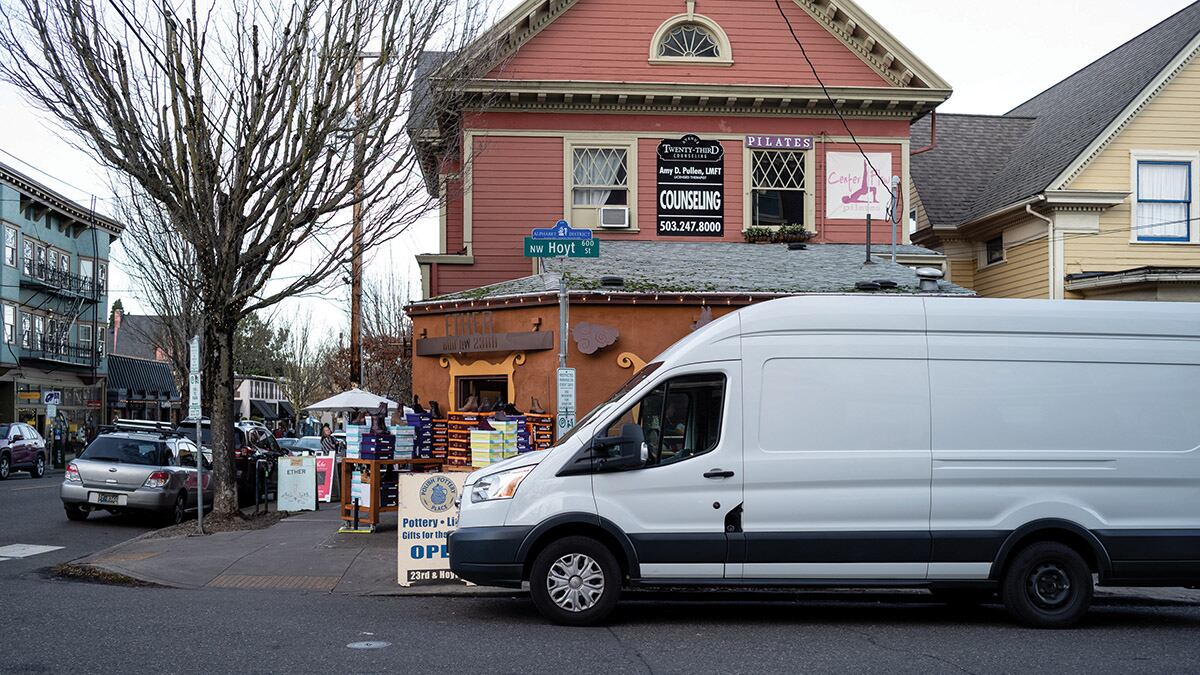Portland transportation advocate Izzy Armenta has a beef with the city. He doesn't understand why Portlanders park their cars right up to the edge of intersections where there are crosswalks.
For pedestrians crossing the street, "there's very limited visibility," says Armenta. "I have to peek out to make sure no one's coming."
Oregon state law actually forbids cars from parking within 20 feet of a crosswalk.
But Oregon law also gives individual cities "road authority," meaning they may choose how to enforce parking rules. And in a city where streetside parking is in short supply, the Portland Bureau of Transportation hasn't painted yellow lines at most intersections to forbid motorists from parking close to a corner.
Next month, Armenta and the pedestrian advocacy group he represents, Oregon Walks, will ask the Portland City Council to direct PBOT to comply with the state's 20-foot law. They say it's a necessary step to fulfill the city's commitment to eliminate traffic deaths, a policy called Vision Zero.
"It's odd they're doing this and they've committed to Vision Zero," says Armenta.

PBOT spokesman John Brady says his bureau is working to create more "daylighted corners," where cars are kept away from intersections that don't have a stop sign or traffic light. As of last year, crosswalks at new road projects are daylighted, as long as they're on the city's list of pedestrian-priority streets. And the city will retrofit streets if Portlanders complain and PBOT deems an intersection dangerous enough to daylight.
But paint yellow stripes along most of the city's thousands of intersections? Nope.
"It was Portland's choice to define the rules in this way," says Brady, who shifts the blame to city leaders' predecessors. "That was a decision of earlier policymakers, and we don't know what their rationale was."
Others think the benefits of daylighted corners are clear.
"Portland basically lacks the political will to take the heat that would come if they went through and said, 'You can't park here anymore,'" says injury lawyer Scott Kocher, an advocate for safer streets. "It boggles my mind that Portland would disregard that, and even if they thought they found some loophole, why on earth would they?"
Related: Portland spends millions to stop cars from killing people. It's not working.
Commissioner Chloe Eudaly, who oversees PBOT, says "both data and common sense tell us that daylighted corners are safer for everyone." But she also says she's pleased with the bureau's current approach.
The fight over daylighted corners is poised to become the latest way safety advocates can pressure City Hall to take more dramatic action to reduce traffic deaths, which have spiked this year ("Blindsided," WW, Aug. 21, 2019). But in this case, advocates risk provoking a powerful adversary: Portland motorists tired of driving in circles to find street parking.
Along thoroughfares like Northwest 23rd Avenue and Southeast Division Street, where residential streets bleed into commercial districts, car parking is already limited. Daylighting every troublesome corner in Portland would vastly decrease parking capacity, raising the ire of drivers and business owners who fear less parking would mean less business.

PBOT finds itself in a difficult position, satisfying neither of two influential groups: safety advocates who think daylighted corners could save lives, and motorists who struggle to find parking in an increasingly congested city.
Brady says it's "too speculative" to say whether daylighted corners prevent traffic injuries: "I don't think you can make a general statement about whether it helps or hurts an intersection."
But Brady does concede that national studies suggest daylighting reduces crashes.
Critics say it's obvious. "Corners are very important for both the pedestrian and driver," says Jonathan Maus, who runs the website BikePortland. "When you're in a car and trying to creep out and you can't see around another parked car, you pretty much have to enter the cross street in order to see. That puts you and puts others at risk."
In 2018, after advocates complained loudly to the city that some Portland crosswalks were dangerous, PBOT launched an online request process in which residents could report troublesome intersections.
Brady says 54 intersections have been daylighted this year, thanks to complaints and new construction.
But Kocher calls the complaint-driven process a "feeble half-measure." He says it caters to the city's wealthiest residents, adding that it's "ridiculous to make that incumbent on citizens."
Earlier this year, Oregon Walks launched a social media campaign to raise awareness of daylighted corners.
Armenta says his group received pushback to the campaign from business owners and some residents in congested areas like downtown and the inner eastside, fearing less parking would hinder business traffic. He disagrees.
"That's a misconception," Armenta points out, "because those roads could have increased bike parking if there weren't as many car spaces, and it would make it more walkable."
Kocher doesn't see the issue as polarizing. He thinks it's just common sense.
"This isn't a modal issue, this is essential for all people walking, biking, motorcycle, scootering," says Kocher. "But I don't think the city will change this practice until a court of law tells them to."

